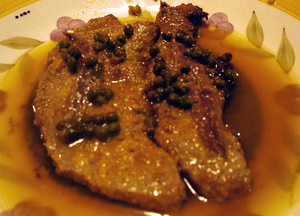Veal facts for kids
Veal is the meat of young cattle, called calves. It is different from beef, which comes from older cattle. Most veal comes from male calves from dairy farms. Veal is known for its soft and tender texture.
Contents
Veal as Food
Veal has been an important ingredient in Italian and French cuisine for many years. It is often served as thin slices called cutlets. Famous dishes include the Italian cotoletta and the Austrian Wiener Schnitzel.
Some classic French veal dishes are:
- Fried escalopes (thin slices)
- Fried veal Grenadines (small, thick steaks)
- Stuffed paupiettes (meat rolls)
- Roast joints (larger pieces of meat)
- Blanquettes (a creamy stew)
Veal has less fat than many other meats. Because of this, it needs to be cooked carefully so it doesn't become tough. Veal is often coated in breadcrumbs before frying. It is also often eaten with a sauce. Veal Parmigiana is a well-known Italian-American dish. It is made with breaded veal cutlets.
Animal Welfare Concerns
How veal calves are raised has become a topic of debate regarding animal welfare.
Many groups that care about animal welfare focus on factory farming. They try to teach people about some veal production methods they believe are not kind to animals. This has made people think more about how their food is produced. It has also led to changes in the veal industry.
A big movement about veal started in the 1980s. Pictures were shared showing veal calves kept in small crates where they could barely move. After seeing these photos, many people started buying less veal.
Many veal farmers listened to what their customers were saying. They have begun to make conditions better on their farms.
The American Veal Association announced plans to stop using small crates by 2017. These crates were often the main reason for the debate in veal farming. Strauss Brands was the first veal company in the US to raise calves completely free and in groups since 2008.
Some people think the crates are bad because calves cannot move much and might get sick. However, some in the veal industry say the crates help keep calves from getting diseases or getting hurt. They also say it allows farmers to give more personal care to each calf.
Other ways male dairy calves are raised include:
- Raising "bob veal" (calves are slaughtered when they are only 2 or 3 days old).
- Raising "red veal" without strict food limits. This means fewer antibiotic treatments and fewer calves are slaughtered.
- Raising them to become dairy beef.
When calves are raised freely, they do not experience the stress of being confined. They also stay with their mothers and other calves. Many veal producers are realizing this. The demand for free-raised veal is growing fast.
In 2007, less than 5% of veal calves were raised in a group setting. By 2009, this number had grown to 35%.
Veal Crate Bans
Many places have made veal crates illegal, or are working to ban them.
Bans in Europe
Veal crates became illegal in the UK in 1990. A full ban for the entire European Union started in 2007. Switzerland, which has a large dairy industry, still uses crates.
Raising veal calves in certain ways is not allowed in many Northern European countries, like Finland. In Finland, it is illegal to give an animal food that is known to be bad for it. It is also illegal to not give an animal enough food.
Bans in the USA
Crates are slowly being banned in the United States. As mentioned, several large veal producers and the American Veal Association are working to end the use of veal crates.
Here are the states that have banned veal crates:
- 2006 - Arizona (ban started in 2012, part of Proposition 204)
- 2008 - Colorado (ban started in 2012)
- 2008 - California (ban started in 2013, part of Proposition 2)
- 2009 - Maine (ban started in 2011)
- 2009 - Michigan (ban started in 2013)
States with current proposed laws to ban veal crates:
- New York State (proposed in May 2009, planned to start in 2015 if passed)
- Massachusetts (proposed in January 2009, planned to start in 2015 if passed)
Images for kids
See also
 In Spanish: Carne de ternera para niños
In Spanish: Carne de ternera para niños





